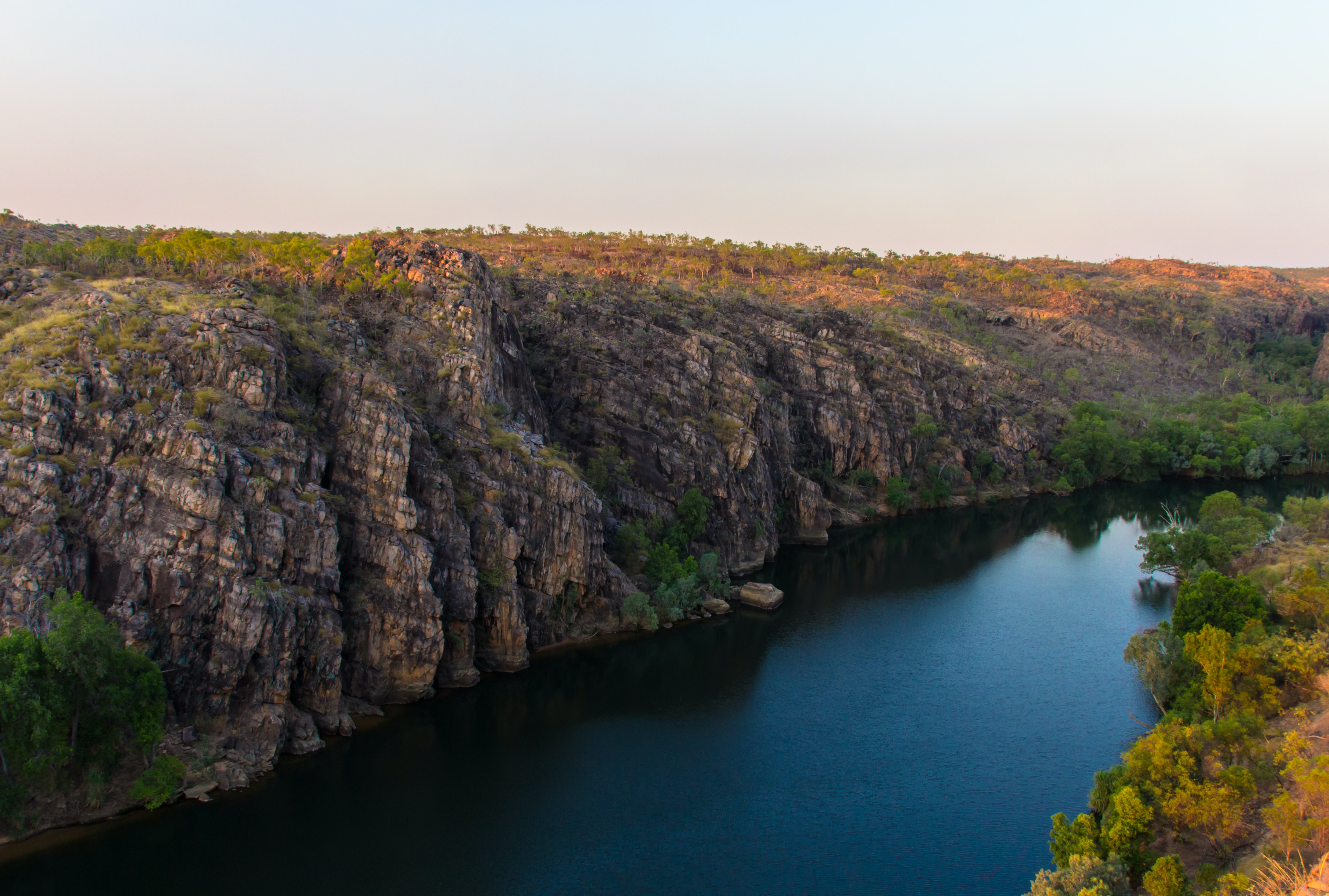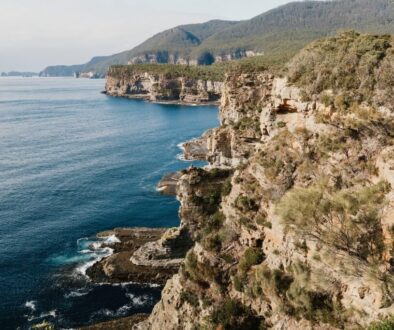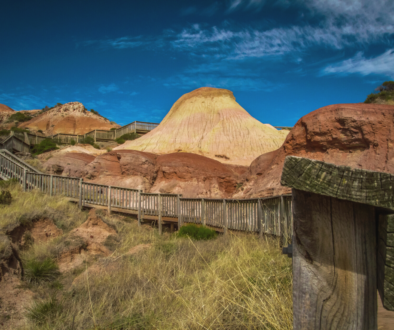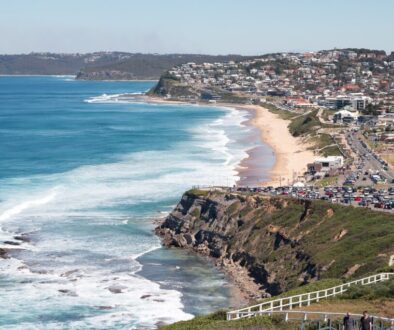Despite what many people think, the Northern Territory’s Top End is a great destination to visit even in the wet season. Sure, it can be a bit humid and you might have to deal with the occasional storm, but the wet is also a time of great natural beauty! Myself, my sister, and our friend did a roadtrip around the NT’s top end from Boxing Day to New Years Day, and despite the rain we LOVED it! The tropical rainforests come alive during that time of year, and the waterfalls are at their most impressive. Plus, there are fewer crowds and rates are often lower than during the dry season. So if you’re looking for an adventure-filled trip full of beautiful scenery, make sure to add the Top End to your list, and check out our recommendations below!
If road tripping isn’t your thing, don’t worry; you can always base yourself in Darwin and visit these places as day tours!
Darwin
Start your top end road trip in Darwin, which is a great place to visit all year round, but the best time to go is during the dry season (May to September). This is when you’ll have the most sunny days and the least chance of rain. You can fly into Darwin International Airport from all major Australian cities. Once you’re in Darwin, getting around is easy – just hop on one of the many buses that run throughout the city. There’s no shortage of things to do in Darwin! Take a stroll through Mindil Beach Markets, go for a swim at beautiful Leanyer Recreation Park, learn about Indigenous culture at the Museum and Art Gallery of the Northern Territory, and don’t forget to catch a sunset over Darwin Harbour. With its tropical climate, beautiful beaches and laid-back vibe, Darwin is the perfect place to relax and soak up some Australian sun.

Litchfield
Litchfield National Park is one of the NT’s most popular tourist destinations, and it’s easy to see why. Located just a short drive from Darwin, the park is home to a diverse range of natural attractions, from waterfalls and rainforests to gorges and rock pools. Whether you’re looking for a day trip or a longer adventure, Litchfield National Park is the perfect place to explore the unique beauty of the Australian Outback.
To make the most of your visit, there are a few things to keep in mind. First, be sure to pack plenty of water and sunscreen – the weather can be very hot, even in the cooler months. Second, wear closed-toe shoes and long pants to protect yourself from insects and vegetation. Third, remember that Litchfield National Park is a wilderness area – please respect the environment by taking all your rubbish with you when you leave. Finally, if you’re travelling in the wet season, certain places may be closed or not safe for swimming due to crocodiles, so always be croc safe and follow the instructions on signs.
Darwin to Berry Springs
Berry Springs Nature Park is a stunning wetland area located just 90 minutes from Darwin. The park features swimming holes, shaded picnic areas, and a huge diversity of birdlife. Visitors can also enjoy hiking, biking, and horseback riding along the park’s trails.Berry Springs Nature Park is one of the most popular attractions in the Litchfield area. The park is open every day from sunrise to sunset and offers a variety of activities for visitors to enjoy. picnicking, swimming, and birdwatching are just a few of the activities that visitors can enjoy.Berry Springs Nature Park is an excellent place to visit for a day trip or an overnight camping trip. There are a number of campgrounds located within the park, as well as several cabins that are available for rent. Whether you’re looking for a place to relax and enjoy the outdoors or you’re looking for an adventure, Berry Springs Nature Park is the perfect place for you.
Berry Springs to the Litchfield Termite Mounds
As you arrive at Litchfield National Park, be sure to stop at the designated termite mound viewing area. On one side of the road, you’ll see a field of towering cathedral mounds built by Nasutitermes exitiosus termites. These mounds can reach up to six feet in height and are made up of a hard outer shell with a hollow centre. The termites build these massive mounds in order to regulate the temperature and humidity levels inside their nests. On the other side of the road, you’ll see a different type of termite mound known as a magnetic mound. These mounds are built by Syntermes dirus termites and are shorter and squatter than the cathedral mounds. However, they are equally fascinating, as they are always oriented in a north-south direction with the broad flat sides facing east and west. Scientists believe that this orientation helps to regulate the internal temperature of the nests, as the flat sides provide Maximum sunlight exposure during winter months when solar radiation is at its weakest. So make sure you stop and marvel at these wondrous mounds and learn something new about these amazing insects when you arrive at Litchfield!

Waterfalls and Swimming Holes
Litchfield National Park is best known for its stunning waterfalls and crystal-clear swimming holes. Visitors can cool off beneath cascading waterfalls, paddle in spring-fed pools or take a dip in one of the many natural rock pools. The most popular spot for swimming is at the base of Florence Falls, where 160 steps lead down to the waterhole. For those looking for a more adventurous swim, nearby Wangi Falls features a large rock pool that is perfect for diving into.


Tolmer Falls is one of the most popular attractions in the Northern Territory. The falls are located in a narrow gorge, and the water cascades over two massive escarpments. There are two cliffside platforms that provide views of the falls, and swimming is not permitted in the area. However, there is a lot to see and do at Tolmer Falls. The gorge is home to rare orange horseshoe bats and ghost bats, and visitors can also learn about the local Aboriginal culture. In addition, the area is also home to a variety of plant and animal life. Tolmer Falls is an amazing place to visit, and it’s sure to mesmerize anyone who sees it.

Buley Rockhole
Located in the Litchfield National Park, Buley Rockhole is a series of plunge pools and cascading waterfalls that are perfect for a refreshing swim. The walk from Florence Falls is relatively easy and takes around 25 minutes. Once you arrive at Buley Rockhole, you can relax on the large flat rocks that surround the pools or take a dip in the refreshing water. There are also a number of small caves and rock overhangs that provide some relief from the heat of the day. Whether you’re looking for a quick swim or a place to spend the day, Buley Rockhole is a great option.


After a huge day of driving, swimming, and exploring, we spent the night in a lodge at the Pandanus on Litchfield caravan park, one of the many options for accomodation around Litchfield.
Katherine/Nitmiluk National Park
The drive from Litchfield National Park to Katherine is one of the most scenic drives in all of Australia. The journey takes you through lush rainforests, towering sandstone cliffs and pristine rivers. Along the way, you’ll have the chance to spot some of Australia’s native wildlife, including kangaroos, wallabies and crocodiles. The drive takes approximately three hours, so be sure to allow plenty of time to enjoy the scenery. And when you arrive in Katherine, be sure to visit Nitmiluk National Park for an even more breathtaking experience.


Situated in the Top End of Australia’s Northern Territory, Nitmiluk National Park is home to some of the most spectacular scenery in the country. The park is located within the traditional lands of the Jawoyn people, and its name comes from the Jawoyn phrase ‘Nitmiluk’, meaning ‘cicada place’. The park is best known for its series of 13 gorgeous gorges that make up Katherine Gorge, a continuous fissure carved by the Katherine River. The striking rock formations and cliffs that surround the gorge have been formed over millions of years by the erosive force of the river. Today, these towering cliffs are a popular destination for rock climbers and abseilers. The best way to experience Katherine Gorge is from the water, or from above on one of the numerous walking trails that wind through the park’s lush rainforest and provide panoramic views of the gorges. Whether you’re admiring the view from above or exploring from below, there’s no doubt that Katherine Gorge is one of Australia’s most spectacular natural wonders. Whether you’re looking to explore the outdoors or simply relax in natural surroundings, Nitmiluk National Park is an ideal destination.


We spent the night at the Countour Hotel in Katherine, before heading to Kakadu the next day!
Kakadu National Park
Kakadu National Park is one of Australia’s most remarkable places. It is a living cultural landscape with exceptional natural and cultural values. Kakadu has been home to Aboriginal people for more than 50,000 years, and many of the park’s extensive rock art sites date back thousands of years. Kakadu’s rock art provides a window into human civilisation in the days before the last ice age. Detailed paintings reveal insights into hunting and gathering practices, as well as the relationships between people and the natural world. The artworks also provide an important record of environmental change over time. Today, Kakadu National Park is a World Heritage Site and an important place for both conservation and Aboriginal culture. Visitors can explore the park’s many different landscapes, including open woodlands, wetlands, rainforests, and sandstone escarpments. There are also opportunities to learn about Aboriginal culture through Rangers programs and guided tours. Whether you’re interested in history, nature, or culture, Kakadu National Park is sure to have something to offer.
We recommend starting by visiting the Kakadu National Park Visitors Centre, which has a great information centre and informative display. You can ask one of the guides there for a park map and they will recommend the best sites for you to visit based on how long you’re staying and the time of year; Kakadu is Australia’s largest national park, so there’s no shortage of things to see and do!

Kakadu is home to some of the most breathtaking natural scenery in Australia. And what better way to experience it than by getting out and exploring on foot? There are plenty of walking trails to choose from, ranging from short and easy strolls to multi-day treks. Whether you want to wander around world-class rock art sites, hike along escarpments or simply take a leisurely stroll around a billabong, there’s something for everyone. Just be sure to stay on the designated paths and pack plenty of water, a hat and sunscreen. With so much to see and do, you’re sure to have an unforgettable experience.
Learn about Australia’s best Aboriginal rock art at Ubirr
Kakadu National Park is home to some of the most stunning Aboriginal rock art sites in the world. Ubirr is one of these sites, and it is famous for its different art styles. The x-ray paintings are particularly impressive, as they show the abundance of bush food in the area, such as fish, waterfowl, mussels, wallabies, goannas, echidnas and yams. In Ubirr’s main gallery, you can see examples of rock art that represent one of the longest historical records of any group of people in the world. The artwork is incredibly detailed and fascinating to look at. If you’re interested in learning more about Aboriginal culture, Ubirr is definitely worth a visit.

Cruise around Yellow Water Billabong
There’s no better way to see the wildlife of Kakadu than by taking a cruise around the Yellow Water Billabong. As you glide through the lily-covered waters, you’ll hear the calls of birds echoing all around you. Keep your eyes peeled and you might also spot a crocodile basking in the sun, or a wallaby hopping through the underbrush. During the wet season from July to November, you can even take a walk across the floodplains to reach a viewing platform on Home Billabong. Just be sure to stick to the marked path, as this is prime crocodile territory! Whether you’re looking for adventure or simply want to relax and take in the scenery, Yellow Water Billabong is sure to please.

We stayed the Aurora Kakadu Lodge, before heading back to Darwin.
The drive from Kakadu to Darwin is one of the most scenic in Australia. The journey takes you through some of the country’s most beautiful countryside, including the stunning Kakadu National Park. Along the way, you’ll also have the opportunity to see some of Australia’s iconic wildlife, such as kangaroos and crocodiles.


Darwin is known for its crocodiles, and a jumping crocodile tour is a great way to see these amazing creatures up close. During the tour, you’ll sit in a small boat as it glides through the water, giving you an up-close look at the crocodiles as they sun themselves on the banks or swim through the water. You may even see one of the crocodiles jump out of the water to catch a fish! The tour guide will provide commentary about the crocodiles and their habitat, and you’ll learn about the efforts to protect these majestic creatures. If you’re looking for an exciting and educational activity, a jumping crocodile tour is a great choice!




